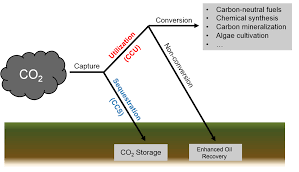CURRENT AFFAIRS
Get the most updated and recent current affair content on Padhaikaro.com
Carbon Capture and Utilization Technologies
- Vaid's ICS, Lucknow
- 26, Feb 2022

Why is it in the news?
- Most Carbon Capture and Utilization and Storage (CCUS)technologies, which capture carbon dioxide (CO2) from the atmosphere and turn it into fuel or other useful goods, may fail to contribute to the world reaching Net Zero emissions by 2050, says a study performed by Radboud University.
- According to the findings of the study, the vast majority of these systems are energy intensive, and the end product can contribute to CO2 emissions into the environment.
- In order to achieve “net zero emissions,”it is necessary to achieve a net balance between greenhouse gas emissions created and greenhouse gas emissions removed from the environment.
What exactly are CCUS?
- Carbon Capture, Utilization, and Storage (CCUS) is a broad term that includes methods and technologies for removing CO2 from flue gases and the atmosphere, recycling the CO2 for use, and determining safe and permanent storage options. CCUS is also known as carbon capture, utilisation, and storage (CCUS).
- When carbon dioxide is extracted using CCUS technology, it is transformed into fuel (methane and methanol), refrigerants, and construction materials.
- The trapped gas is utilised in a variety of applications, including fire extinguishers, pharmaceutical, food & beverage, and agricultural applications.
- CCUS technologies have the potential to make a significant contribution to the achievement of net zero objectives, particularly as one of the few alternatives available to combat emissions from heavy industries and to extract carbon from the atmosphere.
- CCUS is widely regarded as a key instrument for assisting nations in halving their emissions by 2030 and reaching net-zero emissions by 2050.
- These objectives are critical in order to accomplish the Paris Agreement’s aim of keeping global warming to 2 degrees Celsius (°C), and preferably 1.5 degrees Celsius (°C), over pre-industrial levels.
What are some examples of CCUS applications?
- While alternative energy sources and energy-efficient systems have been adopted to slow the pace of CO2 emissions, a reduction in the total quantity of CO2 in the atmosphere is necessary to prevent the negative effects of climate change.
Farming: Capturing CO2 from biogenic sources such as plants and soil to increase agricultural development in a greenhouse has the potential to be successful.
- Using CO2in conjunction with steel slag (an industrial byproduct of the steel making process) to create construction materials that are compliant with the Paris Agreement targets is an example of industrial use.
CCU is already making inroads into the Indian market for enhanced oil recovery. The Oil and Natural Gas Corporation, for example, has inked a Memorandum of Understanding (MoU) with Indian Oil Corporation Limited (IOCL) for Enhanced Oil Recovery (EOR) by injecting CO2.
What are some of the difficulties related with CCUS?
- Carbon capture is expensivebecause it requires the creation of sorbents that can successfully bind to the CO2 contained in exhaust gas or the atmosphere, which is a time-consuming and expensive process.
- Lower Demand for Recycled CO2:Adding economic value to CO2 by converting it into usable chemicals of commercial interest, or by employing it for oil extraction or the remediation of alkaline industrial wastes, would reduce the demand for this greenhouse gas.
- Although there is an increasing demand for CO2, the supply is restrictedwhen compared to the massive quantity of CO2 that must be removed from the atmosphere in order to mitigate the negative environmental effects of climate change.
The Best Way Forward
- Any technology for storing carbon that is sustainable must be effective and economically competitive, stable enough to be used for long-term storage, and ecologically safe.
- Countries should concentrate their efforts on a small number of innovations that have the most potential and channel funding toward them.
- Using clean energy to absorb CO2 and convert it into synthetic fuel, such as methanol generated by CCU, is likely to be an effective mitigation method only if it is combined with other mitigation strategies.
Facts for Prelims:
Sea Cucumber
In Context
- Indian Coast Guard seized live Sea Cucumbers about 120 nautical miles off Kavaratti Island in Lakshadweep.
What is a Sea Cucumber?
- They are an important constituent of the marine ecosystem as they play an important role in maintaining the health of the ecosystem.
- It has no limbs or eyes, or blood.
- There are some 1,250 known species, and many of these animals are shaped like soft-bodied cucumbers.
- Demand: Sea cucumbers are in high demand in China and Southeast Asia, where they are consumed as food and used in medicine.
- This endangered species is primarily smuggled from Tamil Nadu to Sri Lanka.